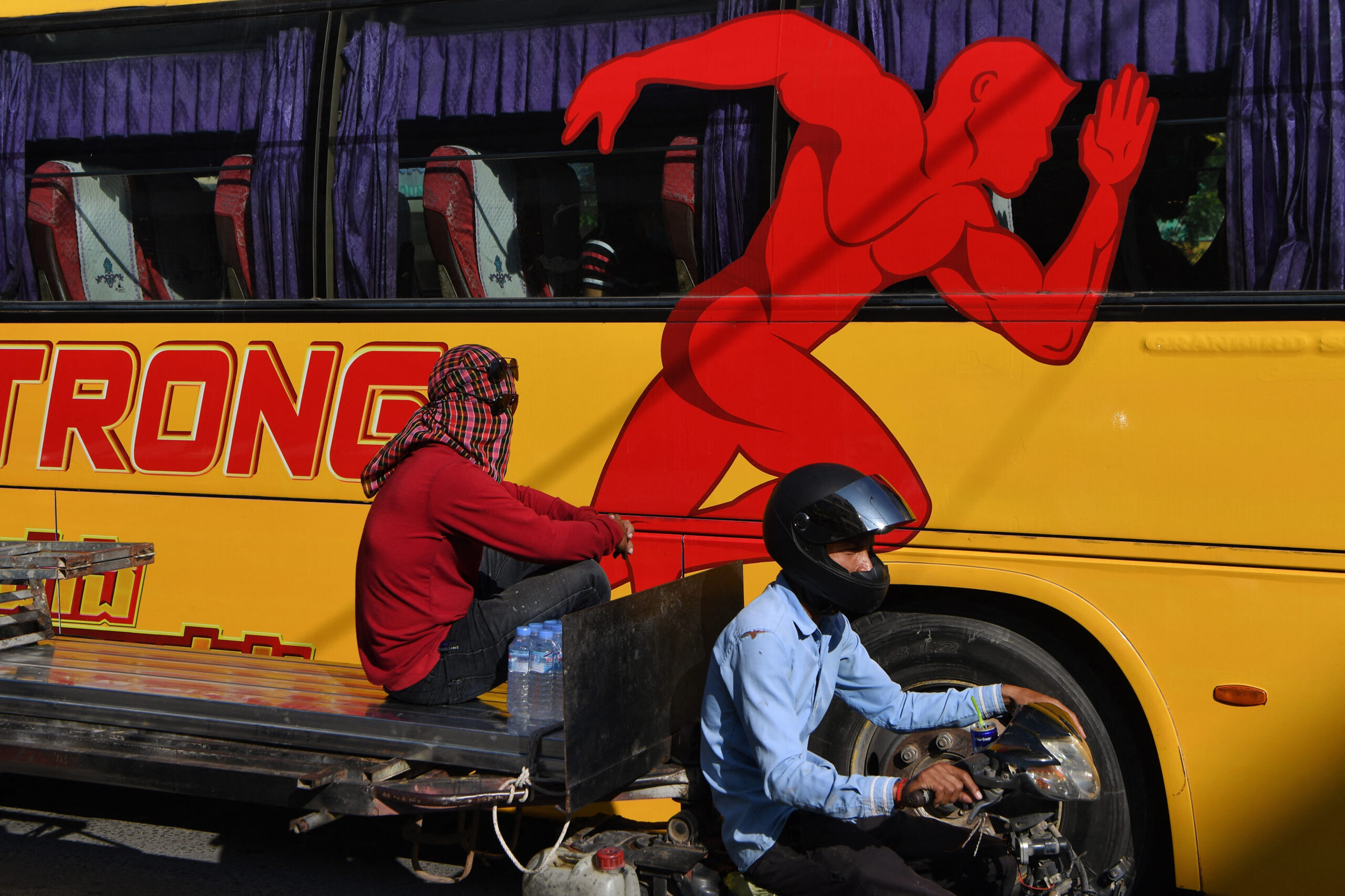Along Phnom Penh’s riverside promenade, an empty water taxi leaves a passenger pier, continuing its journey along a mostly deserted route. At the city’s only train station, empty carriages stutter toward the airport, only to return still vacant. Throughout the city’s boulevards, buses run with mostly open seats despite being new and comfortable.
The unused public transportation system was the city’s status quo long before Covid-19 forced suspensions. And ever since, the city’s 2.1 million residents have been left with few options other than braving the sea of honking tuk tuks, cars, motorcycles and their combined exhaust.
Phnom Penh remains one of the few Southeast Asia capital cities without meaningful public transportation, which is why the Cambodian government has its eyes set on developing a modern light rail network. The ambitious undertaking reached an important milestone in April when long-awaited feasibility studies and initial proposals for three rail-oriented mass transit solutions were reviewed by the Ministry of Transportation and Public Works, though the government has yet to make a final decision.
With an estimated cost of between $1 billion and $1.4 billion, the citywide light rail promises a comprehensive transportation upgrade by the latter half of the decade. Yet the project’s success is not guaranteed, while the high profile and cost underline the significance of Phnom Penh achieving sustainable urban mobility.
Phnom Penh’s flagship light rail project should carefully consider the mistakes the city made with past public transportation projects, which were hampered by the failure to appreciate the necessity of a cohesive network, resulting in piecemeal application and eventual neglect.

Phnom Penh is no stranger to rolling out public transit networks and nurturing them with heavy subsidies, only for them to languish. While previous attempts including bus, water taxi, and train were sensible choices, they were envisioned as separate entities rather than part of a connected and coherent whole — a fatal flaw for any transit system.
Since 2018, the water taxi along Phnom Penh’s riverfront has run from north to south, with stops along the way at important destinations. It should have greatly eased pressure on the city’s main boulevards. Even though there was early interest due to its novelty, ridership tanked in the months afterwards. This was because each stop was disconnected from other transit, effectively stranding passengers after they left the station.
Around the same time, the Airport Rail Link was inaugurated for public use. It created a critical connection from the city’s centre to its international airport, alleviating pressure from the congested Russian Boulevard. But Phnom Penh’s old colonial train station proved ill-suited to serve as a hub for a wide variety of transport options. As it currently stands, passengers are required to take another means of transport just to reach the station, while travellers arriving from the airport are left stranded as well. Moreover, the rail was forced to share a route with other vehicles, creating a dangerous environment due to lax traffic enforcement and unseparated tracks.
The most widely used public transit option — the Phnom Penh City Bus, which started in late 2014 — hasn’t taken off, even after Japan and China donated fleets of new, comfortable buses. The bus system’s 2019 rate of 30,000 daily passengers is marginal when compared to total commute numbers in the city, while being far too small to alleviate traffic congestion.
In hindsight, the bus network failed to reach more adopters because it suffered from poor traffic management, including a lack of bus priority stop lights and separated lanes. The result led to lowered bus speed and inconsistent service, compounded by a lack of sheltered bus stops and the poor walkability of Phnom Penh’s streets.
All three networks still lack a unified payment system, which makes it inconvenient and expensive to hop between lines, let alone other transit modes.
The fragmented and disjointed implementation of each public transit network encapsulates Phnom Penh’s failure in realising an effective transit system
The fragmented and disjointed implementation of each public transit network encapsulates Phnom Penh’s failure in realising an effective transit system. Highlighting the city’s neglect to adopt a multi-modal approach to planning its transit system.
As described by the US Department of Transportation, multi-modal transit is planned from the start to accommodate different forms of transportation by dedicating infrastructure and support services for them. Yet questions remain over the practicality of applying this theory to Phnom Penh’s streets.
Fortunately, other cities have found their way out of this predicament, offering important insights for Phnom Penh. The Dutch once faced a similar challenge in Amsterdam, ultimately developing an innovative strategy to accommodate multi-modal transit.
In the 1970s, cars choked Amsterdam’s narrow streets and the city sought more emphasis on public transit systems and active commute options such as walking and cycling..
The Dutch devised an organisational strategy called ‘disentanglement,’ a conscious, carefully planned effort to separate the various modes of transit and place them into different street networks designated specifically for them. Each network then converged at strategic locations to facilitate switching between lines or transit modes.
In general, smaller streets, promenades and alleyways favor active commuters and larger thoroughfares favor buses, private vehicles and trams. Doing so enables each road to better accommodate its respective mode of transit, while reducing conflict points and accidents, making traffic safer for all users.
Phnom Penh can employ a similar strategy to manage its transit networks, although Phnom Penh’s unique urban context will require adaptation.
Any solution must contend with the city’s well laid out but dense urban core, its heavy reliance on motorcycles and an acknowledgement of the notoriously low traffic obedience of city commuters.
Phnom Penh must establish transit hubs as the nucleus of a future public transit system
To start, Phnom Penh must establish transit hubs as the nucleus of a future public transit system. These are strategic intersections of major thoroughfares located across the city’s center and immediate ring road. Japan International Cooperation Agency (JICA) has already identified locations in its urban transport plan for Phnom Penh.
Urban planners must then identify and design new routes connecting these transit hubs. In doing so, Cambodian planners should thoughtfully consider which streets best suit a particular mode of transit and apply a focused street design to accommodate the selected option.
In practice, Phnom Penh’s dense but roughly orthogonal street layout makes it easier to carve out these distinct routes, in a manner where no mode of transport would be unfairly forced to take a circuitous route for the sake of another. For instance, north and south travel can utilize the central and expansive Preah Norodom and Preah Monivong boulevards, which are ideal for light rail and city bus service. The more moderately sized Preah Trassak Peam and Pasteur streets can be designated as part of the private car network.
Planners will also have to lean into Phnom Penh’s love of motorcycles, preferably by recognising motorcycles as a separate network from cars. Preah Yukanthor street, a quieter route, can be part of the motorcycle network.
This leaves Preah Sisowath Quay, a riverside avenue, as the perfect candidate for a pedestrian and cyclist path.
In the latest urban mobility report on Phnom Penh, Cambodian researchers diagnosed inadequate provision for pedestrians and cyclists as a major obstacle holding back public transportation. Encouragingly, the strategy of streamlining streets would retain more space for sidewalks.
Streets that accommodate a mix of pedestrian, cyclist and public transit modes enjoy a number of benefits, including improving public health by encouraging walking and cycling, spurring engagement with local businesses and promoting environmental sustainability.
Additionally, decreasing driving lanes frees space to employ separated lanes for bikes and pedestrians to keep them safe from faster and heavier motor vehicles. Experts recommend utilizing vegetation, curbs and even parking spaces as buffers for cyclists and pedestrians. At intersections, curbside extensions at corners slow drivers, keep them from cutting into pedestrians or cyclists and retain line of sight and alertness for those crossing the intersection.
A pedestrian-friendly city is integral to a mulit-modal approach, as it will facilitate commuters’ first and last mile of travel to or from the nearest bus or train station. Short trips with private vehicles will be discouraged, further reducing congestion.
Cambodian planners should go beyond just executing a single system, and focus on developing a multi-layered, integrated and accessible transit system. They can achieve this by building well-designed transit hubs, adopting a unified payment system, disentangling modes of transport into separate networks and using the street space gained to emphasize active commutes.
This outline is a path for Phnom Penh to avoid the empty carriages and open seats of the present and move toward a future where sustainable urban mobility is a reality for every inhabitant.
Aronsakda Ses is a young research fellow at Future Forum interested in everything related to cities and urban design. He trained as an architect in Thailand and is conducting research on Phnom Penh’s urban planning.


